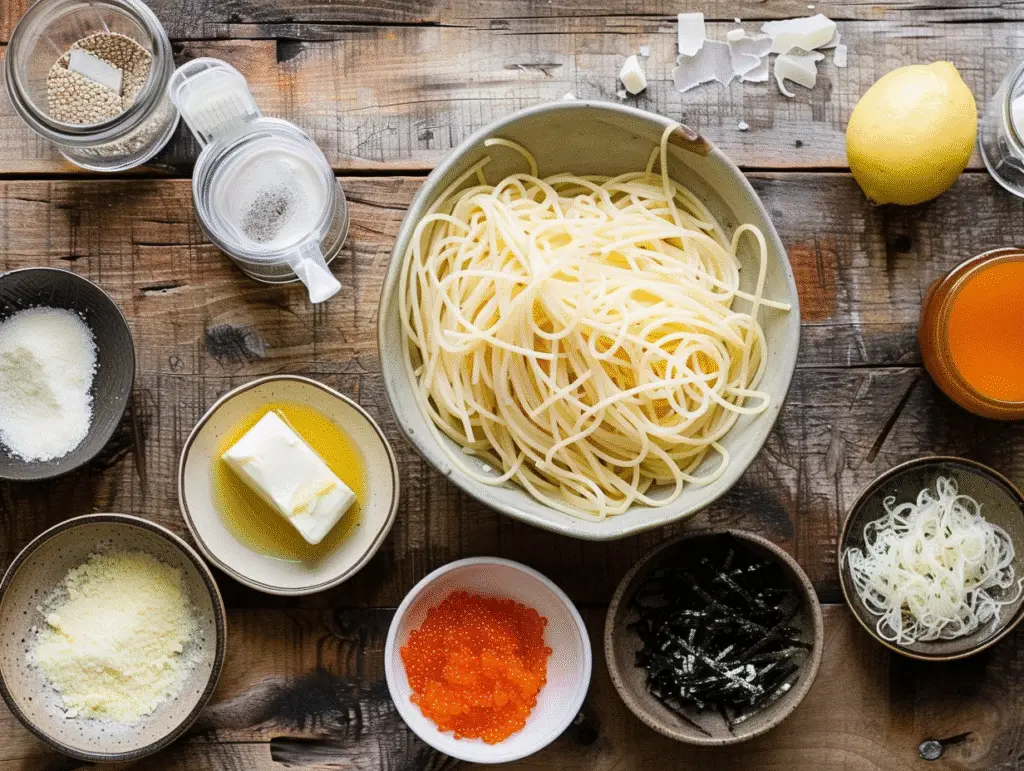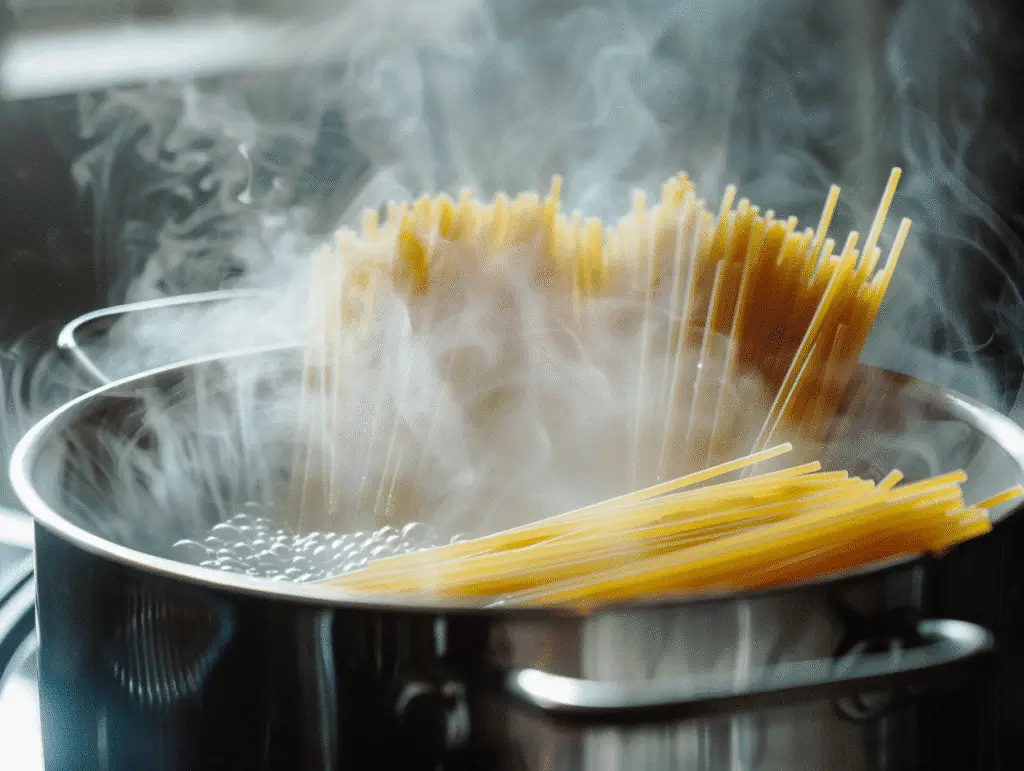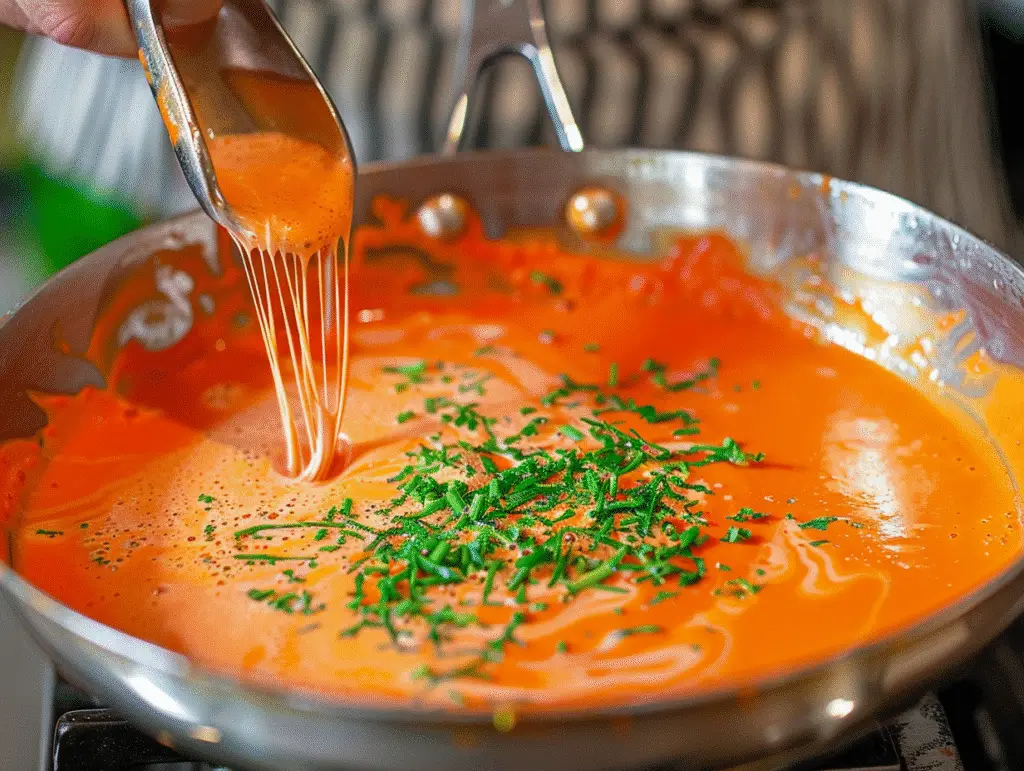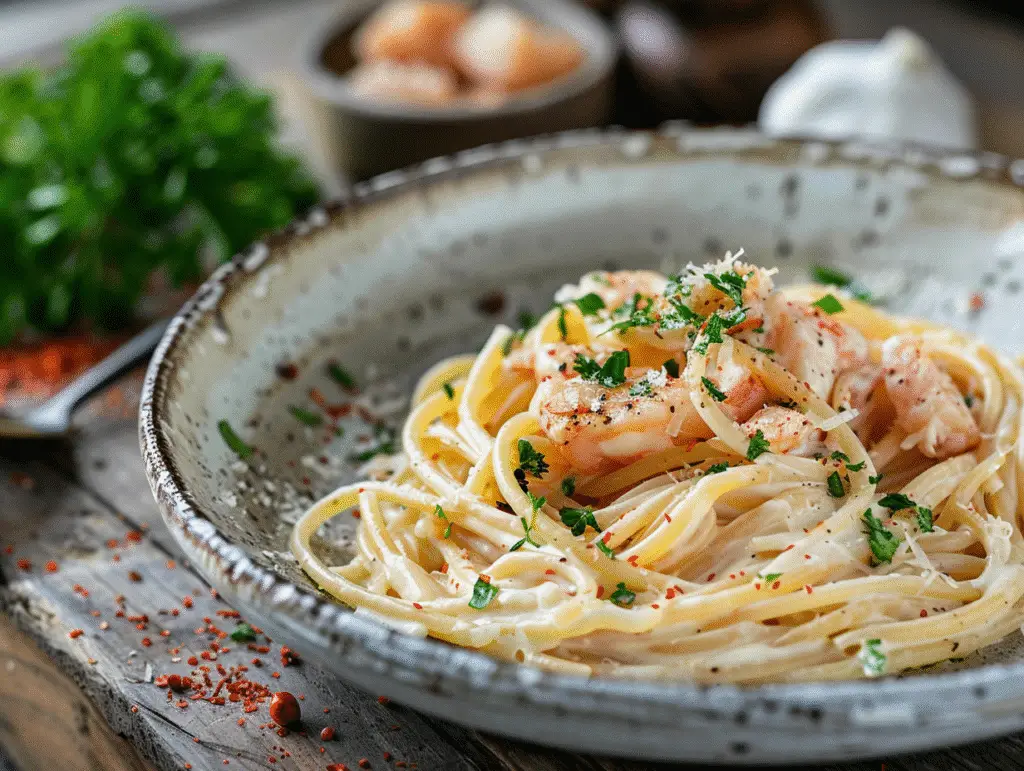There’s something magical about a dish that’s both comforting and exciting. For me, creamy mentaiko pasta has been that ever since my trip to Tokyo five years ago.
I remember ducking into a small café tucked between a ramen shop and a bakery. The owner insisted I try their “mentaiko cream spaghetti.”
The pasta arrived in a simple white bowl, crowned with a generous mound of glistening pink roe. Steam curled up in little swirls, carrying a salty, savory aroma.
One bite, and I knew this was a dish I’d keep coming back to. The creamy sauce and ocean-kissed tang were unlike anything I’d tasted before.
It reminded me of the quiet joy I get from a rainy Sunday afternoon cooking something slow and soul-warming—like my favorite creamy garlic butter shrimp or japanese omurice.
This creamy mentaiko pasta isn’t just a quick dinner. It’s an experience that lingers, a flavor you’ll crave long after the plates are cleared.
Print
Creamy Mentaiko Pasta That Melts in Your Mouth
- Total Time: 20 minutes
- Yield: 2 servings 1x
Description
Creamy mentaiko pasta made with spicy cod roe, butter, and cream for a rich and satisfying Japanese-inspired dish.
Ingredients
200g spaghetti
2 sacs mentaiko (about 60g)
150ml heavy cream
2 tbsp butter
1 tsp lemon juice
Shredded nori for garnish
Instructions
Cook pasta in salted water until al dente.
Melt butter in a pan and add cream, heating gently.
Remove from heat and stir in mentaiko.
Add pasta to sauce, using pasta water to adjust texture.
Garnish with nori and serve immediately.
Notes
For more spice, add extra mentaiko before serving.
Pair with a crisp white wine for a balanced meal.
- Prep Time: 5 minutes
- Cook Time: 15 minutes
- Category: Pasta
- Method: Stovetop
- Cuisine: Japanese
Nutrition
- Serving Size: 1 bowl
- Calories: 520
- Sugar: 3g
- Sodium: 880mg
- Fat: 22g
- Saturated Fat: 12g
- Unsaturated Fat: 8g
- Trans Fat: 0g
- Carbohydrates: 65g
- Fiber: 3g
- Protein: 20g
- Cholesterol: 85mg
Keywords: creamy mentaiko pasta, mentaiko recipe, Japanese pasta
Table of Contents
Part 1: The Story Behind Creamy Mentaiko Pasta
How mentaiko became a creamy comfort dish
Creamy mentaiko pasta, made with spicy cod roe, has deep roots in Japanese and Korean cuisine. It’s briny, slightly spicy, and when paired with butter or cream, turns into something luxurious. I first learned to make creamy mentaiko pasta in my own kitchen after struggling to recreate that Tokyo café magic. The trick was balancing the richness of the cream with the natural saltiness of the roe so that neither overpowered the other. Just like the first time I perfected my garlic fried rice, I had that “yes, finally!” moment when everything came together—pasta coated in silky sauce, with a sprinkle of nori for texture.
Why this dish keeps winning hearts
Part of the charm lies in how fast creamy mentaiko pasta comes together. In less than 20 minutes, you have something that tastes like it took hours. It’s a popular weeknight option in Japan, but also makes an elegant choice for dinner guests. Its flavor profile—rich, savory, a little spicy—hits so many pleasure points at once. It’s that same “can’t put your fork down” quality you get from deeply satisfying comfort meals like spicy miso ramen or teriyaki salmon bowls. The balance of creamy texture and bright seafood umami is what makes people instantly ask for seconds.
Part 2: Ingredients and Preparation for Creamy Mentaiko Pasta

Choosing the right mentaiko
For creamy mentaiko pasta, the quality of your roe makes a huge difference. Mentaiko is pollock or cod roe marinated in chili and seasoning, and the spice level can vary. Fresh mentaiko from a Japanese grocery is ideal, but frozen works well if it’s thawed properly. I like using mildly spicy mentaiko for balance, since the cream already softens the flavor. Some brands offer mentaiko already portioned in small pouches, which makes prep even quicker—perfect for busy nights when you’re deciding between pasta or something like chicken katsu curry. If you can only find tarako (plain cod roe), you can still make this dish; just add a pinch of chili flakes for that signature kick.
Balancing creaminess and umami
The heart of creamy mentaiko pasta is the sauce. You’ll need heavy cream or half-and-half for richness, butter for silkiness, and just enough pasta water to keep it from turning heavy. I like to whisk the cream and mentaiko off the heat to preserve the roe’s texture, similar to how you’d treat eggs in carbonara. A squeeze of lemon juice brightens the flavors, while shredded nori or chopped scallions on top add freshness. The magic comes from the contrast: the briny burst of mentaiko against the smooth cream, like the sweet-salty harmony in korean bulgogi beef.
Part 3: How to Cook Creamy Mentaiko Pasta
Step-by-step method for perfect pasta
Cooking creamy mentaiko pasta is all about timing.
First, bring a large pot of salted water to a boil. Cook your pasta—spaghetti or linguine work best—until just al dente.

While the pasta cooks, prepare your sauce base in a separate pan. Melt butter over low heat, then add cream and stir gently until warmed.

Remove the pan from the heat before stirring in the mentaiko. This way, the roe keeps its delicate pop.
When the pasta is ready, reserve a ladle of pasta water. Drain the pasta and toss it directly into the sauce.
Add the pasta water gradually to adjust the consistency until each strand is coated in glossy, pink-tinted cream.

This process reminds me of the same gentle care I take when making tantanmen ramen. Low heat and patience bring the best results.
Small tips that make a big difference
For an even creamier texture, finish the pasta by tossing it in the sauce over very low heat for 30 seconds. Don’t skip garnishes—they add flavor and visual appeal. Shredded nori, sesame seeds, or finely sliced shiso leaves all complement the dish’s savory richness. If you want a spicier kick, mix in a little extra mentaiko just before serving. And while creamy mentaiko pasta shines on its own, pairing it with a light side like chilled cucumber salad or even a small bowl of spicy miso ramen makes for a comforting, well-rounded meal.
Part 4: Serving, FAQs, and Final Thoughts on Creamy Mentaiko Pasta

Creamy mentaiko pasta is best served immediately while the sauce is still silky. For a cozy dinner, I like to serve it in warm bowls with a sprinkle of fresh herbs and a side of crusty bread to soak up every last drop. If you’re hosting, consider pairing it with a crisp white wine and light appetizers, such as edamame or a fresh seaweed salad. This dish can be the centerpiece of a Japanese-inspired dinner alongside favorites like teriyaki salmon bowl and garlic fried rice.
| Ingredient | Amount |
|---|---|
| Spaghetti | 200g |
| Mentaiko | 2 sacs (about 60g) |
| Heavy cream | 150ml |
| Butter | 2 tbsp |
| Lemon juice | 1 tsp |
Conclusion
Creamy mentaiko pasta is proof that you don’t need hours in the kitchen to make something truly special. It’s fast enough for a weeknight and elegant enough for guests. With its blend of creamy richness and ocean-fresh umami, it’s a dish that turns any meal into a moment worth remembering. Whether you’re a seasoned cook or just learning to make Japanese-inspired meals, this pasta is one you’ll want in your regular rotation.
for more recipes follow me in facebook , Home Page
FAQs
How to make creamy mentaiko pasta?
Boil pasta until al dente, then make a sauce with butter, cream, and mentaiko off the heat. Toss pasta in the sauce, adding pasta water to adjust consistency, and garnish with nori or scallions.
What is mentaiko pasta made of?
It typically includes spaghetti, mentaiko (spicy cod roe), butter, heavy cream or half-and-half, and seasonings like soy sauce or lemon juice. Garnishes such as shredded nori or sesame seeds are common.
What does mentaiko cream taste like?
It’s rich and creamy with a salty, briny depth from the roe. The spice from mentaiko balances the cream, creating a flavor that’s savory, slightly sweet, and a little spicy.
What does mentaiko mean?
Mentaiko refers to seasoned pollock or cod roe, often marinated with chili peppers. It’s a popular ingredient in Japanese and Korean cooking, known for its salty and slightly spicy profile.




